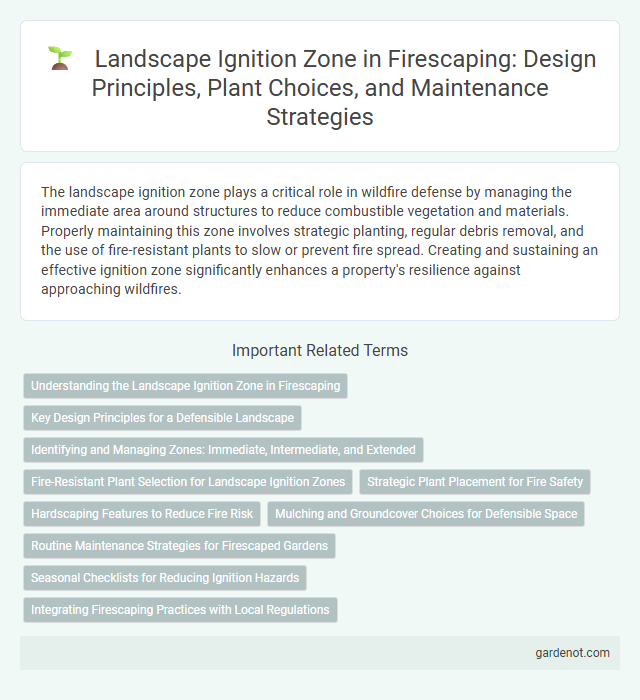The landscape ignition zone plays a critical role in wildfire defense by managing the immediate area around structures to reduce combustible vegetation and materials. Properly maintaining this zone involves strategic planting, regular debris removal, and the use of fire-resistant plants to slow or prevent fire spread. Creating and sustaining an effective ignition zone significantly enhances a property's resilience against approaching wildfires.
Understanding the Landscape Ignition Zone in Firescaping
The landscape ignition zone refers to the area surrounding a structure where vegetation and combustible materials can ignite and potentially cause fire damage. Managing this zone involves strategically selecting fire-resistant plants, maintaining proper spacing, and removing dead or dry vegetation to reduce wildfire risk. Effective firescaping within the ignition zone enhances defensible space, improving a property's chances of surviving nearby wildfires.
Key Design Principles for a Defensible Landscape
A well-designed landscape ignition zone integrates non-combustible materials and strategic plant placement to minimize fire risk. Emphasizing adequate spacing, the use of fire-resistant plants, and maintaining clear zones free of dead vegetation enhances defensibility. Incorporating hardscaping elements such as gravel or stone pathways creates effective barriers that slow fire spread and safeguard structures.
Identifying and Managing Zones: Immediate, Intermediate, and Extended
The landscape ignition zone is divided into three key areas: the Immediate Zone within 5 feet from structures, the Intermediate Zone extending 5 to 30 feet, and the Extended Zone reaching up to 100 feet or more. Managing these zones involves reducing combustible materials, maintaining defensible space, and selecting fire-resistant plants to lower ignition risks. Proper zone identification and tailored vegetation management enhance fire resilience and protect property from wildfire threats.
Fire-Resistant Plant Selection for Landscape Ignition Zones
Selecting fire-resistant plants for landscape ignition zones significantly reduces the risk of wildfire damage to properties. Opt for species with high moisture content, low resin or oil levels, and minimal dead material accumulation, such as succulents, deciduous trees, and certain native shrubs. Proper spacing between plants and regular maintenance further enhances the vegetation's resistance to ignition and helps protect structures from advancing flames.
Strategic Plant Placement for Fire Safety
Strategic plant placement within the landscape ignition zone significantly reduces fire risk by creating natural firebreaks and minimizing combustible materials near structures. Selecting fire-resistant plant species with low resin content and maintaining proper spacing prevents fire from spreading to homes and critical assets. Incorporating hardscape elements like stone pathways and mulched beds further enhances fire safety by interrupting potential ignition paths.
Hardscaping Features to Reduce Fire Risk
Hardscaping features such as stone patios, driveways, and retaining walls create effective fire barriers within the landscape ignition zone, minimizing the spread of flames. Incorporating non-combustible materials like concrete, gravel, and brick further reduces fuel continuity and enhances fire resistance near structures. These elements are critical in defensible space design by interrupting fire pathways and lowering overall fire risk to properties.
Mulching and Groundcover Choices for Defensible Space
Selecting fire-resistant mulch such as gravel, crushed stone, or inorganic options minimizes combustible materials within the landscape ignition zone, reducing fire risk. Opting for low-flammability groundcovers like succulents, native grasses, and herbaceous plants creates effective defensible space by limiting fuel continuity. Regular maintenance, including clearing dead plant debris and avoiding excessive mulch layers, further enhances landscape resilience against wildfires.
Routine Maintenance Strategies for Firescaped Gardens
Routine maintenance strategies for firescaped gardens prioritize reducing the landscape ignition zone by regularly removing dead vegetation, pruning trees and shrubs to maintain proper clearance, and irrigating plants to keep soil and foliage moist. Consistent debris removal, especially dry leaves and mulch, minimizes potential fuel sources that can ignite during wildfires. Implementing these practices enhances the fire-resistant qualities of the landscape, protecting properties while maintaining aesthetic appeal.
Seasonal Checklists for Reducing Ignition Hazards
Seasonal checklists for reducing ignition hazards in the landscape ignition zone emphasize removing dead vegetation, clearing dry leaves, and maintaining proper spacing between plants to prevent fire spread. Inspecting and trimming trees, cleaning gutters, and keeping lawn areas well-watered are critical steps to minimize fuel for wildfires throughout different seasons. Consistent application of these practices enhances defensible space and significantly reduces the risk of ignition during high fire danger periods.
Integrating Firescaping Practices with Local Regulations
Integrating firescaping practices with local regulations ensures landscape ignition zones are designed to minimize wildfire risks while complying with municipal codes. Strategic plant selection, proper spacing, and the use of fire-resistant materials within these zones align with fire safety guidelines established by agencies like the National Fire Protection Association (NFPA). This approach enhances property protection and supports community-wide wildfire mitigation efforts through regulatory adherence.
Landscape ignition zone Infographic

 gardenot.com
gardenot.com